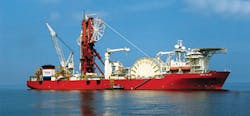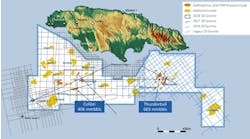Bruce Beaubouef • Houston
Operators adapting to market, revising their strategies
Amidst the stark realities of today’s market, operators are revising their exploration plans and field development strategies. And while layoffs are being announced and budgets being cut, some operators are reaffirming their commitment to the Gulf of Mexico, particularly its deepwater frontier regions.
For example, Chevron recently announced that it had placed all of its shallow-water GoM assets up for sale in an effort to focus on its deepwater business. That move is part of the company’s plans to restructure its Gulf of Mexico activities. Now, Chevron says it is accelerating those plans.
“Chevron is continuing to adapt to the evolving business environment by revising organizational structures, increasing efficiencies and reducing expenses,” Chevron spokesman Cam Van Ast told the Houston Business Journal. “In the Gulf of Mexico, this includes transitioning to a deepwater-focused business with fewer, more complex assets.” Chevron expects its shallow-water divestments to be completed by the end of 2017, Van Ast said.
Through the end of 2015, Chevron generated $11.5 billion in cash through divestments, and it is targeting another $5 billion to $10 billion over 2016 and 2017. According to the Houston Chronicle, the company reportedly is marketing 27 oil and gas fields in the Gulf, which could fetch more than $1 billion.
Meanwhile, Cobalt International Energy says it will eliminate 50 Houston jobs as the company readjusts after the sale of its offshore Angolan assets. The company is looking to reduce its total workforce by about 50%. Those 50 workers account for nearly one-third of Cobalt’s 155-person, Houston-based workforce.
“With the pending transfer of Cobalt’s Angolan assets and its focus on reducing costs, Cobalt is also in the process of restructuring its organization to better align with its post-Angola business needs,” the company announced on Feb. 22.
Last year, Cobalt said it would sell its interest in offshore Angola for $1.75 billion to state-owned Sonangol. Cobalt is exiting Angola entirely in order to strengthen its finances and focus its exploration and production primarily in the deepwater Gulf of Mexico.
“In light of the current market environment, Cobalt is taking action focused on increasing efficiency, reducing costs and focusing on work that directly supports business activities,” wrote Wanda Lewis, Cobalt’s vice president of human resources. Lewis’s letter to the Texas Workforce Commission was cited in a Houston Chronicle Fuel Fix report. According to the report, Cobalt counted 352 total workers at the end of 2015. The plan is to cut that number down to 140 workers at the end of the restructuring.
At the same time, Statoil announced plans to double oil production from deepwater wells in the Gulf of Mexico in three years, according to Bloomberg and other online reports. The announcement follows in the wake of the company’s move to cut one in five workers in its US business and the appointment of new managers.
Statoil is bucking the trend among other major developers that are scaling back or outright cancelling their deepwater GoM development to cope with the market downturn. For Statoil, each barrel of oil pumped in the US is five times more valuable than crude produced offshore Norway due to different taxation levels, notes Torgrim Reitan, the former Statoil finance chief who took over the company’s US business last year.
“The Gulf of Mexico is an important part of our future,” said Reitan. “We think of the Norwegian continental shelf as the backbone of Statoil. The US is the spearhead.”
Statoil, which is pumping 40,000 to 50,000 b/d of oil from the Gulf, continues to cut costs and is aiming to lower the profit threshold for its US wells to $50/bbl by the end of 2018 from about $90 in 2014.
In the Gulf, Statoil has five major deepwater developments onstream and another three in the works, Reitan said. Although the company is taking steps to cope with prices that have fallen 70% in 20 months, Reitan said it would be a mistake to assume that market will persist in the long term.
“These days only come along once every 20 years,” he said. “We need to be able to see through this. We must get the business right and prepare for growth when the timing is right.”
BOEM schedules central, eastern lease sales
The Bureau of Ocean Energy Management (BOEM) plans to offer about 45 million acres for oil and gas exploration and development in the Gulf of Mexico in two lease sales on March 23, 2016.
Central Planning Area Lease Sale 241 and Eastern Planning Area Lease Sale 226 will be held consecutively in New Orleans. The sales will be the ninth and tenth offshore auctions under the Administration’s Outer Continental Shelf Oil and Gas Leasing Program for 2012-2017 (Five Year Program).
Sale 241 encompasses about 8,349 unleased blocks, covering 44.3 million acres, located from 3 to 230 nautical miles offshore Louisiana, Mississippi and Alabama, in water depths ranging from 9 to more than 11,115 ft (3 to 3,400 m).
Sale 226 encompasses 162 whole or partial unleased blocks covering about 595,475 acres. The blocks are located at least 125 statute miles offshore in water depths ranging from 2,657 to 10,213 ft (810 to 3,113 m). The area is south of eastern Alabama and western Florida; the nearest point of land is 125 mi northwest in Louisiana.
This is the second of two lease sales proposed for the Eastern Planning Area under the current Five Year Program. According to the bureau, most of the Eastern Gulf of Mexico Planning Area cannot be offered for lease until 2022 as part of the Gulf of Mexico Energy Security Act of 2006.
Deep Gulf Energy taps Technip for UDW work
Deep Gulf Energy III LLC has awarded Technip a lump-sum contract for the development of the South Santa Cruz and Barataria fields in the ultra-deepwater Gulf of Mexico.
These fields are located in Mississippi Canyon acreage, offshore New Orleans, in approximately 2,000 m (6,651 ft) of water.
The contract consists of project management and engineering services; fabrication and installation of approximately 23 km (14 mi) of pipe-in-pipe flowline; design, fabrication, and installation of flowline end terminations, fabrication and installation of jumpers; and pre-commissioning.
The flowline system will be fabricated at the group’s spoolbase in Mobile, Alabama.
The offshore installation is expected to be performed in 2H 2016 by the company’s vesselDeep Blue, the group’s flagship vessel for deepwater pipelay.




